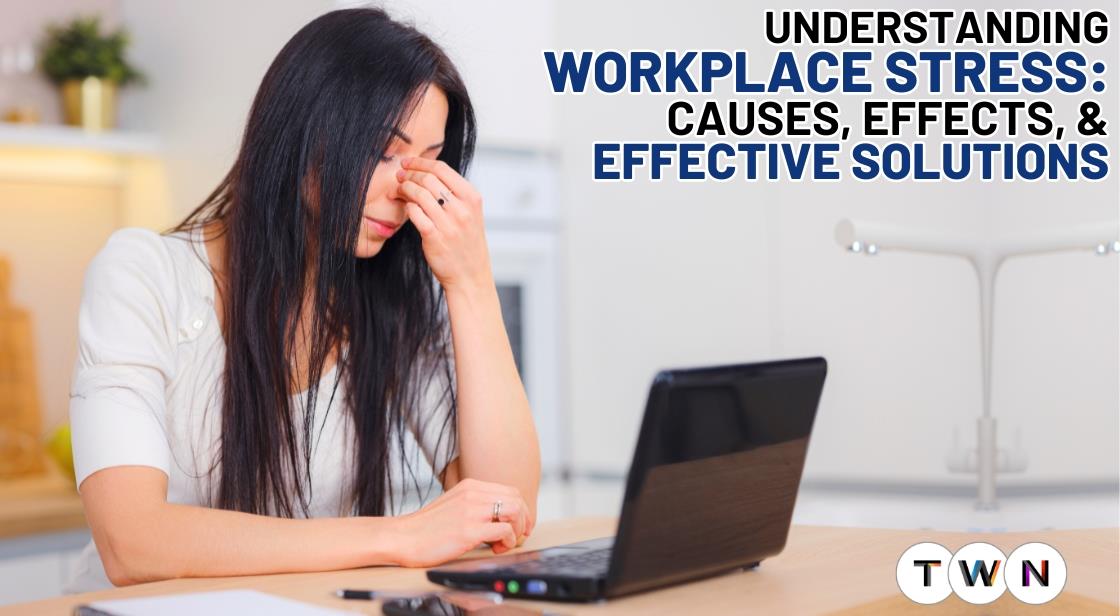Understanding Workplace Stress: Causes, Effects, and Effective Solutions

Blog Post
In today's dynamic and demanding work environment, workplace stress has become an increasingly prevalent concern. Stress at work can stem from various sources, including heavy workloads, long hours, conflicts with colleagues, and unclear job roles.
As organizations strive to meet high expectations and tight deadlines, employees often find themselves grappling with mounting pressure, which can lead to significant physical and emotional strain.
Understanding and addressing workplace stress is not merely a matter of individual well-being; it has profound implications for organizational health and productivity. Stress not only affects employees' mental and physical health but also disrupts team dynamics and impairs overall performance.
As companies navigate a competitive landscape, prioritizing employee mental health and work-life balance is essential for maintaining a motivated, engaged, and effective workforce.
This blog delves into the causes, impacts, and effective strategies for managing workplace stress. By exploring key stressors, understanding their effects on employees and organizations, and implementing practical solutions, we aim to provide valuable insights into creating a healthier, more productive work environment.
Join us as we uncover the role of employers in reducing workplace stress and fostering a culture that supports employee well-being and success.
Workplace Stress Uncovered: Key Causes, Impacts, and Strategies to Overcome
Workplace stress is a common issue faced by employees across industries, and it refers to the physical and emotional strain caused by job-related factors. This stress can result from a variety of reasons, such as long working hours, heavy workloads, conflicts with colleagues, or unclear job roles.
As workplaces become more fast-paced and competitive, the pressure to meet deadlines and expectations intensifies, leading to increased levels of stress. When left unchecked, workplace stress can have detrimental effects on both employees' health and overall productivity.
Importance of Addressing Workplace Stress
In today’s fast-moving and highly competitive business environment, addressing workplace stress is more important than ever. Organizations that prioritize mental well-being and work-life balance are better positioned to retain talent, boost employee engagement, and maintain high productivity levels.
Stress not only affects the individual but also disrupts team dynamics and organizational performance. By actively managing workplace stress, companies can create healthier work environments that foster creativity, collaboration, and innovation.
Ignoring stress at work can lead to burnout, higher absenteeism, and increased turnover rates, all of which can be costly to organizations. Employees under constant stress are less likely to stay motivated, and this can negatively impact the company's bottom line.
Statistics on Workplace Stress
The growing impact of workplace stress is reflected in various studies and reports. According to the World Health Organization (WHO), workplace stress is one of the leading causes of mental health issues, contributing to anxiety, depression, and burnout. In fact, stress-related absenteeism costs companies billions of dollars globally each year.
Additionally, a survey conducted by the American Institute of Stress revealed that 83% of US workers suffer from work-related stress, and approximately 1 million employees miss work each day due to stress.
By understanding the severity and widespread nature of workplace stress, employers and employees alike can take proactive steps to mitigate its impact and create a more balanced, healthy work environment.
What is Workplace Stress?
Workplace stress refers to the emotional, mental, and physical strain caused by the demands of a job that exceed an individual’s ability to cope. It occurs when employees face high-pressure situations, deadlines, or expectations that create a sense of overwhelm. While a certain amount of stress is normal and can even motivate performance, prolonged or intense workplace stress can have detrimental effects on both mental and physical health.
Definition of Workplace Stress
Workplace stress is triggered when the demands of the job do not match the employee's resources, abilities, or support system. It may arise from various factors such as heavy workloads, tight deadlines, conflicts with colleagues, or job insecurity. Stress becomes problematic when it is constant and exceeds an employee’s ability to manage it effectively, leading to burnout and other health concerns.
Difference Between Workplace Stress and General Life Stress
Workplace stress is specifically linked to situations or challenges within a professional setting, such as job tasks, office environment, or team dynamics. General life stress, on the other hand, encompasses broader stressors outside of work, such as financial troubles, family issues, or personal relationships.
While both types of stress can affect well-being, workplace stress is unique in that it often stems from factors like organizational culture, job expectations, and professional relationships. Unlike general life stress, workplace stress often impacts job performance and productivity, making it a critical issue for both employees and employers.
Common Symptoms of Workplace Stress
Workplace stress manifests through both physical and mental symptoms. Common physical symptoms include headaches, fatigue, muscle tension, and stomach issues. Mental and emotional symptoms may involve anxiety, irritability, depression, lack of focus, or feelings of helplessness. Prolonged workplace stress can lead to more severe issues such as burnout, cardiovascular diseases, and weakened immune responses.
Recognizing these symptoms early is crucial to managing stress effectively, maintaining mental health, and fostering a positive work environment.
Causes of Workplace Stress
Key Points:
-
Excessive workload causes stress by increasing pressure and creating unmanageable deadlines.
-
Lack of control over tasks leads to frustration and anxiety.
-
Job insecurity can trigger fear and constant stress due to uncertainty about the future.
-
Poor workplace relationships can create a toxic environment, leading to mental strain.
-
Unclear job roles create confusion and stress, making it hard for employees to perform effectively.
-
Work-life imbalance negatively affects mental health, especially in remote working situations.
Excessive Workload
Heavy workloads, unrealistic deadlines, and long working hours are common stressors in the workplace. When employees are overloaded with tasks, it becomes difficult to manage time and prioritize effectively. This can lead to feelings of being overwhelmed, increased pressure, and burnout.
The constant demand to meet tight deadlines further aggravates the situation, leaving employees with little room for error. Long working hours also reduce opportunities for relaxation and recovery, which can exacerbate stress over time.
Lack of Control
When employees have little control over their tasks or decision-making, it often leads to feelings of helplessness and frustration. Not having the autonomy to decide how or when to complete a task creates stress because employees may feel unable to influence outcomes or address challenges in a way that suits their working style. This lack of control can result in reduced job satisfaction and heightened anxiety, as they feel constrained by rigid structures and protocols.
Job Insecurity
Economic downturns, company restructuring, or downsizing often leave employees feeling insecure about their job stability. The uncertainty surrounding their future employment can cause constant worry and stress. Fear of layoffs or losing income creates emotional strain, and this insecurity can affect both personal well-being and productivity at work. Job insecurity also discourages employees from fully engaging in their work or taking risks, further limiting their performance.
Poor Workplace Relationships
Conflicts with colleagues or supervisors, workplace bullying, and a lack of support from peers or leadership can significantly contribute to workplace stress. Toxic work environments marked by constant tension and unresolved conflicts create a culture of negativity and distrust. Employees in such environments may feel isolated or unsupported, which can diminish their motivation and lead to stress-related mental health issues such as anxiety or depression.
Unclear Job Roles
When employees are uncertain about their roles and responsibilities, it leads to confusion, frustration, and stress. Unclear job expectations make it difficult to prioritize tasks, set goals, or measure success. This ambiguity can cause employees to feel they are constantly falling short of expectations or working on tasks that are not aligned with their actual responsibilities, further fueling anxiety and dissatisfaction.
Work-Life Imbalance
An imbalance between work and personal life is a significant stressor, particularly with the rise of remote working. When work intrudes on personal time, it can lead to exhaustion, burnout, and feelings of resentment. Employees who struggle to maintain boundaries between their work and home life may find it difficult to relax or spend quality time with family and friends. This imbalance negatively impacts mental health, leading to chronic stress and decreased overall well-being.
Also Read: Best Practices for Leaders Integrating AI into the Workplace
Impacts of Workplace Stress
1. On Employee Health
Prolonged workplace stress has significant negative impacts on employee health. When employees face constant pressure without adequate recovery time, they are more likely to experience burnout. This state of emotional, mental, and physical exhaustion can lead to serious mental health issues, such as anxiety and depression.
The physical toll of stress includes cardiovascular diseases, hypertension, migraines, and a weakened immune system, which leaves individuals more susceptible to illness. Chronic stress can also disrupt sleep patterns, resulting in fatigue and poor concentration, further compounding health issues. In the long term, unmanaged workplace stress can result in serious, life-threatening conditions, reducing overall well-being and quality of life.
2. On Productivity
Workplace stress has a direct impact on productivity. Stressed employees often find it difficult to focus, leading to a drop in performance and efficiency. As stress levels rise, the ability to think creatively and make sound decisions diminishes. When employees are overwhelmed, they may struggle to meet deadlines, make errors, and have difficulty prioritizing tasks.
This decline in cognitive function not only affects individual output but can also create bottlenecks in team projects, slowing down progress and innovation. In high-stress environments, employees are more likely to procrastinate, leading to a vicious cycle of falling behind and accumulating stress.
3. On Company Performance
The overall performance of a company is greatly affected by the stress levels of its workforce. High workplace stress results in increased absenteeism, as employees may take more sick days to cope with physical and mental exhaustion. Furthermore, chronic stress can lead to higher employee turnover, as individuals leave stressful environments in search of better work-life balance and healthier workplaces.
This not only increases recruitment and training costs but also leads to a loss of experienced talent. Additionally, when employees are disengaged due to stress, their level of commitment, motivation, and loyalty to the company drops. This reduced engagement can stifle creativity and innovation, ultimately harming the company’s growth and profitability.
4. On Team Dynamics
Workplace stress can significantly affect team dynamics, creating a tense and toxic environment. When employees are under stress, they may become irritable, less patient, and less collaborative, leading to conflicts with colleagues. Stress can impair communication, making it harder for teams to work together effectively. Over time, this can erode trust and cooperation within the team.
When individuals prioritize personal survival over team success, it fosters competition and hostility, which deteriorates the overall workplace culture. A stressed team is less likely to share ideas or support one another, undermining both team spirit and collective performance.
Effective Solutions to Manage Workplace Stress
Workplace stress is a common issue that can negatively impact both employees and organizations. Implementing effective solutions is essential for creating a healthier work environment. Here are some key strategies:
1. Workload Management
Heavy workloads are one of the leading causes of stress in the workplace. To manage this, employees should focus on prioritizing tasks based on importance and deadlines. Breaking large tasks into smaller, manageable pieces can also reduce feelings of overwhelm. Time management tools, such as calendars or task management apps, can help employees stay organized. Setting realistic deadlines is essential, and employees should not hesitate to communicate with their supervisors if a deadline seems unachievable. A balanced workload helps prevent burnout and maintains productivity.
2. Promote Open Communication
Creating a culture of open communication is vital for reducing stress. Employees should feel comfortable discussing their concerns with managers or HR, whether it’s about workload, conflicts with colleagues, or unclear expectations.
Transparent communication fosters a supportive work environment where employees can express their needs without fear of judgment or repercussions. Regular one-on-one meetings and team check-ins help managers stay informed about employee well-being and address stressors early on.
3. Offer Employee Support Programs
Organizations can offer various employee support programs to help employees manage stress. Wellness programs may include access to fitness centers, mental health workshops, or healthy lifestyle incentives. Additionally, offering counseling services allows employees to confidentially discuss any personal or professional issues.
Mental health days can be offered as part of a company’s benefits package, providing employees with time off to recharge without using vacation or sick leave. These programs signal that the company values its employees’ well-being.
4. Promote Work-Life Balance
A good work-life balance is crucial for preventing burnout. Companies should offer flexible work hours or the option for remote work, allowing employees to manage their personal responsibilities while staying productive. Encouraging employees to take regular breaks throughout the day also promotes mental clarity and reduces stress. Employers can further support work-life balance by discouraging after-hours work and setting clear expectations about availability outside working hours.
5. Clear Role Definitions
Stress often arises when employees are uncertain about their roles and responsibilities. Defining clear job descriptions helps prevent confusion and allows employees to focus on their tasks. Regular feedback and evaluations ensure that employees understand their role within the organization and can address any changes or additional responsibilities. Clarity in expectations significantly reduces workplace stress.
6. Stress Management Techniques
Employees can also manage stress through practical techniques like mindfulness and meditation, which help in maintaining focus and reducing anxiety. Incorporating physical activity into the day, even for short periods, can improve mood and energy levels. Taking regular breaks and practicing deep breathing exercises also help in lowering stress levels during a busy workday. These techniques can be taught through workplace wellness programs or adopted individually by employees.
By implementing these solutions, both employers and employees can work together to create a healthier, more productive work environment with reduced stress levels.
6. The Role of Employers in Reducing Workplace Stress
Workplace stress is a significant issue affecting employee well-being and productivity. Employers have a critical responsibility in creating a healthier work environment that minimizes stress and fosters a culture of support, inclusivity, and recognition. Proactively addressing workplace stress can lead to higher employee engagement, satisfaction, and overall organizational success.
1. Responsibility of Employers in Creating a Healthier Work Environment
Employers play a pivotal role in shaping the work environment, and they are responsible for ensuring that it is conducive to both physical and mental well-being. A healthy workplace reduces unnecessary stressors by offering clear communication, manageable workloads, and supportive resources.
Employers should prioritize employee health and wellness initiatives such as flexible working hours, mental health support, and stress management workshops. Additionally, implementing policies that promote work-life balance can help employees feel less overwhelmed and more in control of their work duties.
By investing in ergonomic office setups, encouraging regular breaks, and providing opportunities for professional growth, employers can actively reduce stress and burnout. When employees feel valued and supported, they are more likely to remain engaged and productive.
2. Fostering a Culture of Support, Inclusivity, and Recognition
Managers play a vital role in reducing workplace stress by fostering a culture that emphasizes support, inclusivity, and recognition. Creating an inclusive environment means ensuring that all employees feel respected, regardless of their background or position. This can be achieved by promoting diversity and implementing policies that prevent discrimination and bias.
Support can be extended through open communication channels where employees feel comfortable expressing their concerns. Regular one-on-one meetings between managers and team members can help identify any potential stressors early on and offer timely solutions.
Recognition is another key factor in stress reduction. Employees who feel appreciated are more likely to stay motivated and less likely to experience the stress of feeling undervalued. Managers should recognize individual and team achievements, offer praise for hard work, and provide constructive feedback to help employees grow professionally. Recognition can come in various forms, from verbal appreciation to awards or performance-based incentives.
3. The Importance of Regular Employee Feedback and Engagement
One of the most effective ways for employers to reduce workplace stress is by regularly seeking feedback and engaging with employees to understand their concerns. Surveys, feedback forms, and suggestion boxes can help employers gain insight into specific stress points in the workplace. Regular feedback allows employers to address issues before they escalate, leading to better mental health and a more positive work atmosphere.
Additionally, employee engagement programs encourage workers to participate in decision-making processes, making them feel more connected to the company. Engaged employees are more likely to share their experiences and collaborate on solutions, leading to a less stressful and more harmonious workplace.
By prioritizing employee well-being, fostering a supportive culture, and staying attuned to employee needs, employers can effectively reduce workplace stress and promote a healthier, more productive work environment.
Conclusion
Addressing workplace stress is essential for fostering a healthy, productive, and engaged workforce. Understanding the key causes, such as excessive workload, lack of control, job insecurity, poor workplace relationships, unclear job roles, and work-life imbalance, is the first step in effectively managing stress. The impacts of unchecked stress on employee health, productivity, company performance, and team dynamics highlight the importance of proactive measures.
Employers have a crucial role in creating a supportive work environment. By prioritizing clear communication, manageable workloads, and supportive resources, they can significantly reduce stress levels. Fostering a culture of inclusivity, support, and recognition further contributes to a positive work atmosphere. Regular feedback and engagement with employees allow for the early identification of stressors and help in implementing timely solutions.
You May Like
EDITOR’S CHOICE












